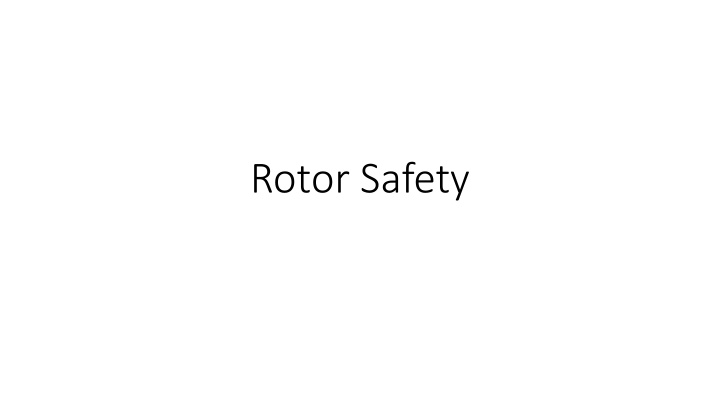



Rotor Safety
Rotor Materials • Aluminum • Lightweight • Can withstand high g-forces and extreme temperature changes without premature fatigue • Titanium Ultraspeed Rotors • Can withstand much higher g-forces than aluminum • Offer superior chemical and temperature change resistance • Stainless Steel Rotors • Useful for some large volume rotors • New Carbon Fiber Rotors • Lighter than aluminum or titanium • Have better chemical resistance and will not corrode when exposed to some regularly occurring laboratory corrosives such as CsCl
Six Causes of f Rotor Failure 1 Incorrect Loading or Balancing 2 Incorrect Attachment 3 Consumable Failure 4 Overloading 5 Corrosion 6 Fatigue
1 Rotor Failure Cause Preventing In Incorrect Loading • Always run centrifuge with ALL buckets in place • Always load buckets symmetrically • Always balance adjacent and opposing loads within manufacturer’s recommended tolerance
2 Ensuring Proper Attachment Rotor Failure Cause • Attachment to Centrifuge • Superspeed rotors must be locked down to centrifuge drive by tightening the lock knob • Lowspeed rotors must be fastened by locking pin • General purpose, small benchtop, and micro- centrifuges must be fastened by locking nut or other mechanism as specified by manufacturer Always double check that your rotor is locked down before pressing start !
Ensuring Proper Attachment 2 Rotor Failure Cause • Swinging Bucket Rotors • Buckets must be placed properly on the swinging arms • Swinging bucket rotors must have all buckets in place • Buckets should be cleaned and lubricated regularly to ensure a free swing out during the run For swinging bucket rotors, gently swing out each bucket to ensure a free easy motion. Always double check before pressing start
3 Rotor Failure Cause Preventing Consumable Failure • Ensure you are not exceeding the maximum rated speed by the manufacturer • Ensure consumable is chemically compatible with your sample • Make sure you have all the parts and use according to the directions • Know the history of shared consumables • Inspect before every use and do not use if signs of wear are apparent • Implement replacement program – consumables should be replaced regularly • If in doubt contact manufacturer and verify proper use
4 Rotor Failure Cause Preventing Overloading • All rotors are designed with a maximum load tolerance at the maximum speed • If the maximum load is exceeded then the maximum speed MUST be derated – ALWAYS check this in the manual and use the formula below • Ultraspeed swinging bucket rotors used for gradient work – density of sample should be verified against speed and temperature to prevent point load failure
5 Rotor Failure Cause Preventing Corrosion • Surface corrosion - caused by long term exposure to moisture or chemicals • Stress corrosion - surface corrosion that is allowed to propagate until microcracks are formed deep into the structure of the rotor • How to prevent surface corrosion: • Clean rotors between every use • Thoroughly dry rotors between uses • Remove adapters between runs • Never use metallic objects to open or remove parts • Always use cleaning, disinfection and sterilization agents that are chemically compatible with the rotor If your application is corrosive consider an alternative rotor material such as carbon fiber!
6 Rotor Failure Cause Preventing Fatigue • Rotors are exposed to high g-forces and do wear out • The molecular structure of the rotor changes as the metal elogongates repeatedly – eventually they will fail! • Ultraspeed rotors have a recommended use and retirement span rated by the number of cycles or hours used • Superspeed rotors are warranted for 10 years and should be considered for retirement even if they are in good condition • All other rotors – the guidelines vary and should be verified before use • All rotors need to be retired – even when they appear to be in good appearance – metallic parts fatigue over repeated uses with no visible signs of wear Have your rotors inspected regularly by a trained technician.
Summary ry – Be Smart, Be Proactive! • Improve the life of your rotor and prevent damaging failures: • Balance properly • Attaching rotor and parts correctly • Proactively managing consumable use • Never overload • Prevent corrosion with best lab practices • Retire rotors • Always follow manufacturer recommendations stated in rotor manual and tube manual for proper use Improve your lab experience by preventing messy spills or catastrophic accidents that cause significant repair costs and loss of your precious samples!
Recommend
More recommend